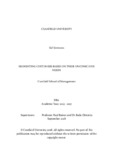JavaScript is disabled for your browser. Some features of this site may not work without it.
| dc.contributor.advisor | Baines, Paul R. | |
| dc.contributor.advisor | Dimitriu, Radu | |
| dc.contributor.author | Simmons, Sid | |
| dc.date.accessioned | 2023-03-02T12:13:20Z | |
| dc.date.available | 2023-03-02T12:13:20Z | |
| dc.date.issued | 2018-09 | |
| dc.identifier.uri | https://dspace.lib.cranfield.ac.uk/handle/1826/19254 | |
| dc.description.abstract | This paper contributes to the literature by proposing a new methodological approach for understanding customers’ unconscious needs. This approach combines Unconscious Thought Theory (UTT) with Choice-Based Conjoint (CBC), for the first time, to identify needs that segment members are either unaware of, or unable/unwilling to articulate. This methodological approach identified an additional market segment, distinct from those identified by a traditional customer segmentation approach based on customer need articulation. Ergo, understanding unconscious needs may provide additional customer insight and aid marketeers in developing new propositions and gaining market share. This study, therefore, makes a methodological contribution to the literature. The study involves the segmentation of buyers of snack bars (i.e. cereal bars), based on subjective nutritional information importance (as revealed on packaging). Separate samples of buyers were recruited: one group as a control sample completing a traditional CBC exercise; a second group completing the same CBC exercise but asked to complete a UTT working memory distraction-task between each choice-task and responding to it. This allowed a comparison of the segmentations of two groups (one which incorporated unconscious thought theory and the other which did not). Latent Class Segmentation (LCS) analysis indicated that whilst both approaches generate four similar segments, the CBC/UTT approach revealed a fifth (hidden) segment, unidentified in the other sample. In addition, the nutritional preferences of four of the five segments produced via the CBC/UTT approach matched those demonstrated by the participants’ store card behavioural data in a manner unobserved for the traditional CBC approach. This research provides a framework for further exploration and identifies a number of issues, such as which types of working memory distraction-tasks are most effective, that could potentially improve the approach if replicated. | en_UK |
| dc.language.iso | en | en_UK |
| dc.rights | © Cranfield University, 2015. All rights reserved. No part of this publication may be reproduced without the written permission of the copyright holder. | |
| dc.subject | Customer needs | en_UK |
| dc.subject | subconscious needs | en_UK |
| dc.subject | implicit needs | en_UK |
| dc.subject | segmentation | en_UK |
| dc.subject | measurement | en_UK |
| dc.subject | unconscious thought theory | en_UK |
| dc.subject | distraction-task | en_UK |
| dc.subject | working memory | en_UK |
| dc.subject | latent class segmentation | en_UK |
| dc.title | Segmenting customers based on their unconscious needs. | en_UK |
| dc.type | Thesis | en_UK |
| dc.description.coursename | Doctor of Business Administration | en_UK |
